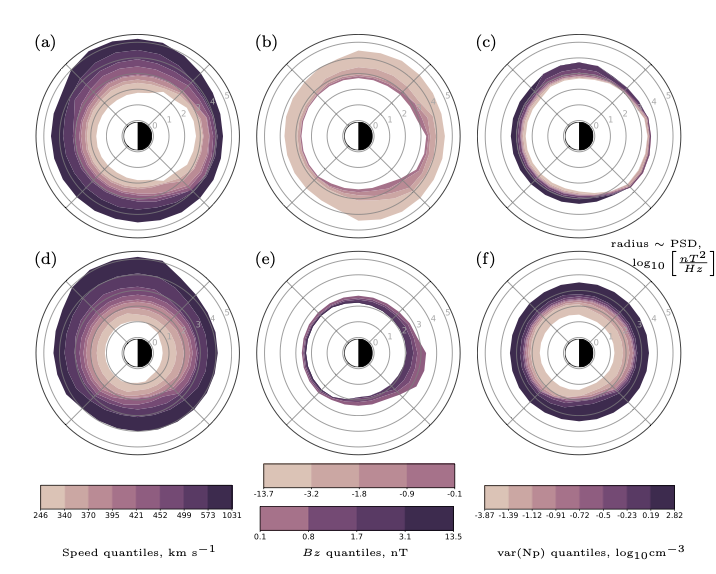MIST
Magnetosphere, Ionosphere and Solar-Terrestrial
Random forest model of ultra‐low frequency magnetospheric wave power
By Sarah Bentley (Northumbria University)
Parameterised (statistical) models are being increasingly used in space physics, both as an efficient way to use large amounts of data and as an important step in real-time modelling, to capture physics on scales not incorporated in numerical modelling. We have used machine learning techniques to create a model for the power in ultra low frequency (1-15mHz, ULF) waves throughout Earth’s magnetosphere. Capturing the power in these global-scale waves is necessary to determine the energisation and transport of high energy electrons in Earth’s radiation belts, and the model can also be used to test how individual wave driving processes combine throughout the magnetosphere.
The model is constructed using ensembles of decision trees (i.e. a random forest). Each decision tree iteratively partitions the given parameter space into variable size bins to reduce the error in the predicted output values. These variable bins mitigate several difficulties inherent to space physics data (sparseness, interdependent driving parameters, nonlinearity) to produce an approximation of ULF wave power in our chosen parameter space: physical driving parameters (solar wind speed vsw, magnetic field component Bz and variance in proton number density var(Np)) and spatial parameters of interest (magnetic local time MLT, magnetic latitude and frequency band).
[frequency, latitude, component, MLT, vsw, Bz, var(Np)] → ULF wave power
It is not always possible to extract all physical processes from parameterised models such as this. Instead we suggest a hypothesis testing framework to examine the physics driving ULF wave power. This formalises the approach taken in full statistical surveys, beginning with dominant driving processes, testing how they manifest in the model, and then examining remaining power.

Figure 1: Variation of ULF wave power at one station, 5mHz. Model-predicted power spectral density is shown by magnetic local time at quantiles of (a) speed (for median Bz < 0 and var(Np)), (b) Bz < 0 (for median speed and var(Np)) and (c) var(Np) (for median speed and Bz < 0). Median values for speed, Bz < 0 and var(Np) are 421 km s−1, −1.8 nT and var(Np) = −0.716 log10(cm−3) respectively. (d)-(f) also show variation of wave power with speed, Bz and var(Np) but for Bz > 0 (with a median value of Bz = 1.7 nT held constant for (d) and (f)). Radius of each quantile corresponds to the power spectral density in log10(nT2/Hz) predicted for those solar wind values, at that station, frequency and magnetic local time.
In the paper we demonstrate how this method of iteratively considering smaller scale driving processes applies to magnetic local time asymmetries in ULF wave power. In Figure 1 we can see the wave power predicted by the model when we change one driving parameter and keep the others constant, for Bz<0 and Bz>0 separately. The MLT asymmetries in power clearly change with both driving parameter and there are two separate behaviour regimes for Bz>0, Bz<0. Digging deeper into these results using the framework, we conclude that
- The dawn-dusk wave power asymmetry is a combined effect of the different radial density profiles and wave driving from magnetopause (“external”) perturbations such as Kelvin-Helmholtz instabilities.
- We cannot account for the effects of a compressed magnetosphere, but var(Np) does not represent wave driving by magnetopause perturbations.
- Nor does Bz, which likely represents wave power increases with substorms.
We also found significant remaining uncertainty with mild solar wind driving, suggesting that the internal state of the magnetosphere should be included in future models.
Please see the paper for full details:
Bentley, S. N., Stout, J., Bloch, T. E., & Watt, C. E. J. (2020). Random forest model of ultra‐low frequency magnetospheric wave power. Earth and Space Science, 7, e2020EA001274. https://doi.org/10.1029/2020EA001274